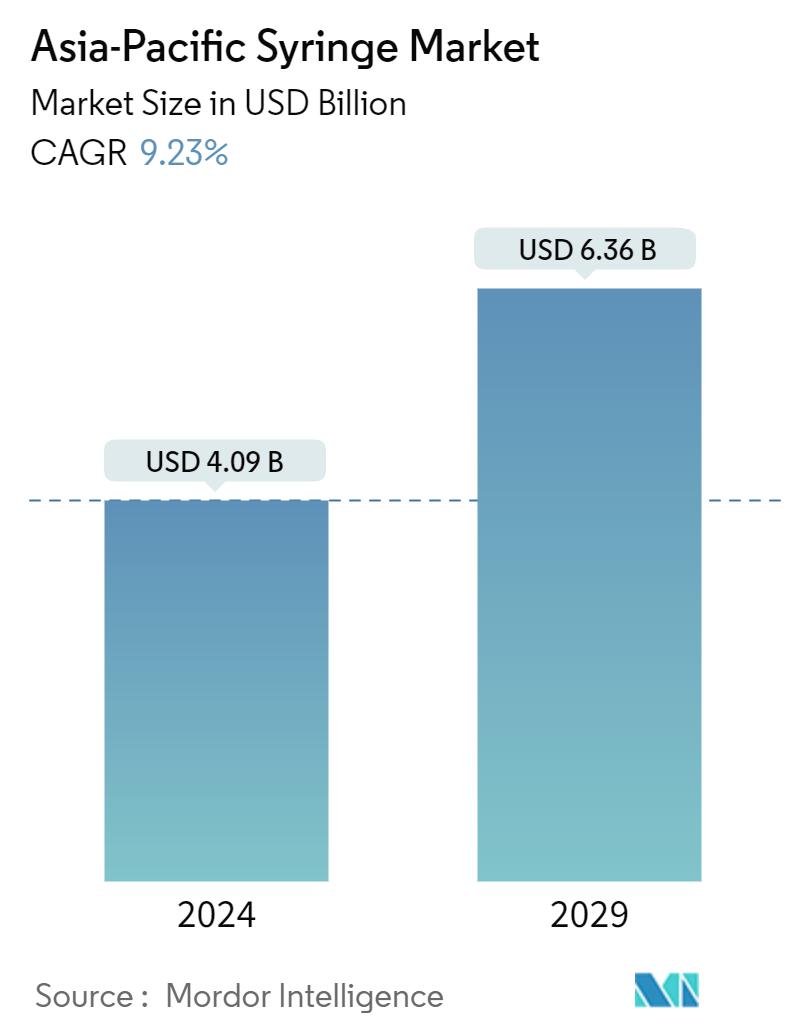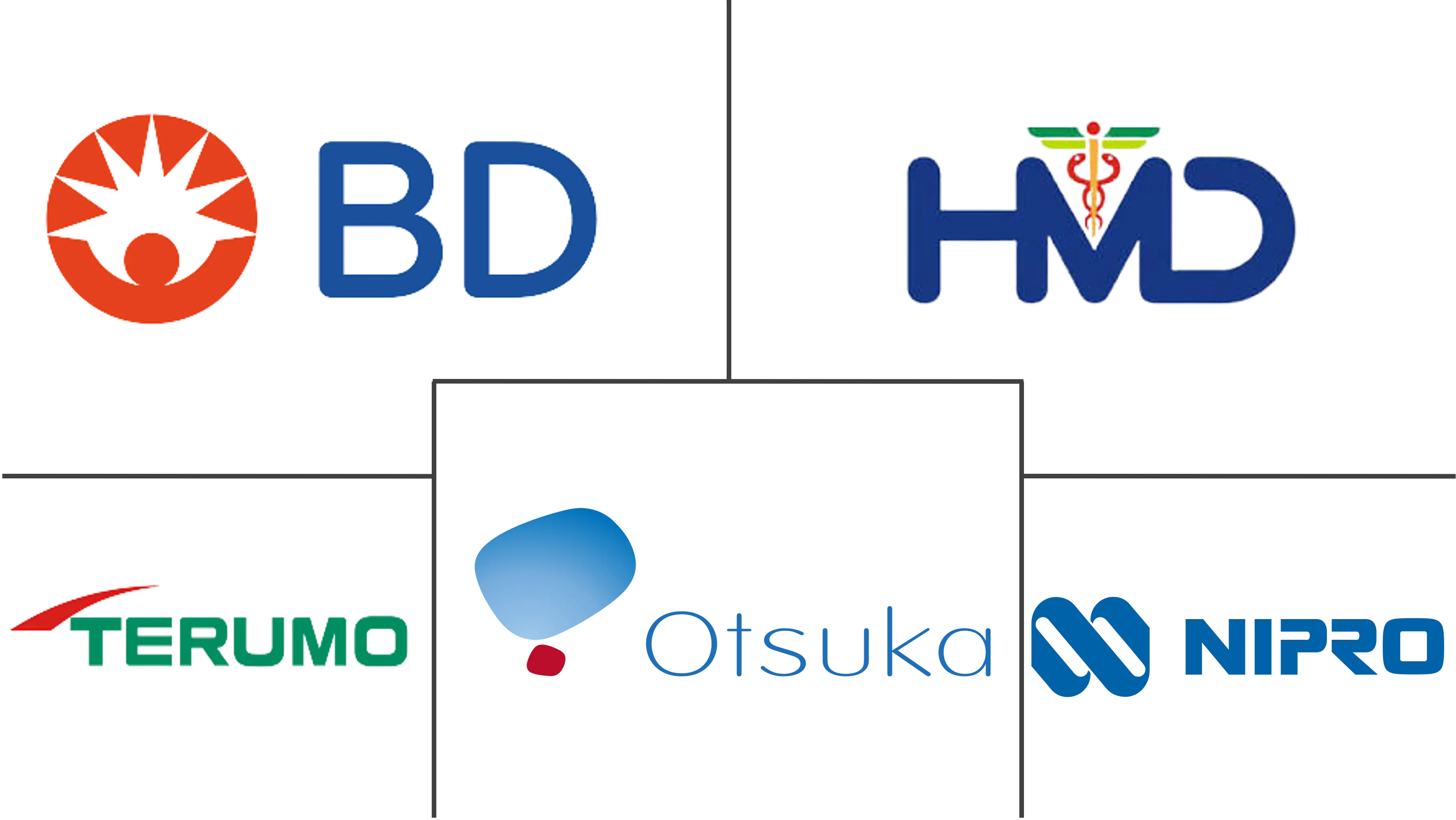Market Size of Asia-Pacific Syringe Industry

| Study Period | 2019 - 2029 |
| Base Year For Estimation | 2023 |
| Forecast Data Period | 2024 - 2029 |
| Market Size (2024) | USD 4.09 Billion |
| Market Size (2029) | USD 6.36 Billion |
| CAGR (2024 - 2029) | 9.23 % |
| Market Concentration | Low |
Major Players
*Disclaimer: Major Players sorted in no particular order |
Asia-Pacific Syringe Market Analysis
The Asia-Pacific Syringe Market size is estimated at USD 4.09 billion in 2024, and is expected to reach USD 6.36 billion by 2029, growing at a CAGR of 9.23% during the forecast period (2024-2029).
The Asia-Pacific syringe market is anticipated to grow with the increasing prevalence of chronic and infectious diseases, rising mass vaccination programs, and manufacturers focusing on launching the product in Asia-Pacific. Over the past decade, there has been an increase in the burden of various chronic complications that require medical interventions and medications that utilize syringes.
Asia-Pacific faces a significant burden of chronic diseases, including cancer, kidney failure, and cardiovascular diseases. To manage these conditions, therapeutic drugs are often administered through syringes, highlighting the importance of syringes in the region's healthcare systems. For instance, as per the data published by the International Agency for Research on Cancer (IARC) in 2023, cancer cases are expected to increase in China in the coming years, with 5.20 million in 2025 and 5.81 million in 2030. Such an increasingly high burden of cancer is anticipated to bolster the volume of chemotherapy, and it will increase the demand for syringes for the administration of drugs, which will increase the growth of the market in the coming years.
Additionally, Japan's large-scale vaccination program necessitates a significant supply of syringes. For instance, according to NHK (Nippon Hōsō Kyōkai) World-Japan, in March 2022, Japanese authorities approved a public vaccination campaign for children between the ages of 5 and 11. In March, many municipalities commenced vaccinating individuals within that age group. Therefore, the rise in syringe demand from Japan will act as a major driver for the Asia-Pacific syringe market, and the surge in production capacity is likely to benefit other countries in the region as well.
Moreover, the recent developments by the market players in Asia-Pacific are expected to increase the penetration of the syringes, which is expected to boost the market growth during the forecast period. For instance, in March 2024, HMD launched Dispojekt, a disposable single-use syringe, an indigenous single-use safety syringe, to reduce cases of needle stick injuries. Further, in April 2023, Delta Med Group and DBM, a leading pre-filled syringe manufacturer, joined forces to expand their product offerings and research capabilities. This strategic partnership leverages the complementary strengths, enhancing their ability to serve customers. The combined entity will benefit from significant synergies, propelling its growth trajectory.
Therefore, the market is anticipated to grow during the forecast period due to the aforementioned factors, such as growing cancer cases, rising public vaccination campaigns for children, and key manufacturers focusing on developing syringes. However, the high number of needle-stick injuries, high cost of safety syringes, and alternate drug delivery methods are likely to impede the market's growth.
Asia-Pacific Syringe Industry Segmentation
As per the scope of the report, the syringe is a device medical professionals use to transfer liquids into or out of the body. It is made up of a hollow needle, which is attached to a tube and a plunger. The Asia-Pacific syringe market is segmented by usability, material, type, application, and geography. By usability, the market is segmented into sterilizable syringes or reusable syringes and disposable syringes. By material, the market is segmented into glass and plastic. By type, the market is segmented into general and specialized syringes. By application, the market is segmented into diabetes, botox, osteoarthritis, human growth hormone, and other applications. By geography, the market is segmented into China, Japan, India, Australia, South Korea, and the Rest of Asia-Pacific. The report offers the value (in USD) for the above segments.
| By Usability | |||||
| Sterilizable Syringes/Reusable Syringes | |||||
|
| By Material | |
| Glass | |
| Plastic |
| By Type | |
| General | |
| Specialised Syringes |
| By Application | |
| Diabetes | |
| Botox | |
| Osteoarthritis | |
| Human Growth Hormone | |
| Other Applications |
| Geography | |
| China | |
| Japan | |
| India | |
| Australia | |
| South Korea | |
| Rest of Asia-Pacific |
Asia-Pacific Syringe Market Size Summary
The Asia-Pacific syringe market is poised for significant growth, driven by the increasing prevalence of chronic and infectious diseases, as well as the expansion of mass vaccination programs across the region. The demand for syringes is bolstered by the rising incidence of conditions such as cancer, kidney failure, and cardiovascular diseases, which necessitate the administration of therapeutic drugs through syringes. Additionally, large-scale vaccination initiatives, particularly in countries like Japan, are contributing to the heightened demand for syringes. Manufacturers are actively launching new products and expanding production capacities to meet this demand, further propelling market growth. However, challenges such as the high incidence of needle-stick injuries, the cost of safety syringes, and the availability of alternative drug delivery methods may impede market expansion.
The market for pre-filled syringes is expected to experience robust growth, driven by their convenience and safety in administering precise dosages of medication. Technological advancements and increased demand for pre-filled insulin injections, particularly in countries with high diabetes prevalence like India, are key factors supporting this growth. The segment's expansion is further supported by strategic developments and partnerships among market players, enhancing their product offerings and research capabilities. India, with its large geriatric population and high burden of chronic diseases, is anticipated to witness significant market growth. The fragmented nature of the market, with numerous global and regional players, underscores the competitive landscape, with companies like Becton Dickinson and Company, Hindustan Syringes & Medical Devices Limited, and Terumo Corporation leading the charge.
Asia-Pacific Syringe Market Size - Table of Contents
-
1. MARKET DYNAMICS
-
1.1 Market Overview
-
1.2 Market Drivers
-
1.2.1 Rising Prevalance of Chronic and Infectious Diseases
-
1.2.2 Increasing Vaccination Programs
-
1.2.3 Increasing Trend of Self-Administration of Injections and Greater Dose Precision in Injections
-
-
1.3 Market Restraints
-
1.3.1 High Number of Needle-stick Injuries and High Cost of Safety Syringes
-
1.3.2 Alternate Drug Delivery Methods
-
-
1.4 Porter's Five Force Analysis
-
1.4.1 Threat of New Entrants
-
1.4.2 Bargaining Power of Buyers/Consumers
-
1.4.3 Bargaining Power of Suppliers
-
1.4.4 Threat of Substitute Products
-
1.4.5 Intensity of Competitive Rivalry
-
-
-
2. MARKET SEGMENTATION (Market Size by Value - USD)
-
2.1 By Usability
-
2.1.1 Sterilizable Syringes/Reusable Syringes
-
2.1.2 Disposable Syringes
-
2.1.2.1 Conventional Syringes
-
2.1.2.2 Safety Syringes
-
2.1.2.3 Prefillable Syringes
-
-
-
2.2 By Material
-
2.2.1 Glass
-
2.2.2 Plastic
-
-
2.3 By Type
-
2.3.1 General
-
2.3.2 Specialised Syringes
-
-
2.4 By Application
-
2.4.1 Diabetes
-
2.4.2 Botox
-
2.4.3 Osteoarthritis
-
2.4.4 Human Growth Hormone
-
2.4.5 Other Applications
-
-
2.5 Geography
-
2.5.1 China
-
2.5.2 Japan
-
2.5.3 India
-
2.5.4 Australia
-
2.5.5 South Korea
-
2.5.6 Rest of Asia-Pacific
-
-
Asia-Pacific Syringe Market Size FAQs
How big is the Asia-Pacific Syringe Market?
The Asia-Pacific Syringe Market size is expected to reach USD 4.47 billion in 2025 and grow at a CAGR of 9.23% to reach USD 6.95 billion by 2030.
What is the current Asia-Pacific Syringe Market size?
In 2025, the Asia-Pacific Syringe Market size is expected to reach USD 4.47 billion.

